Kinshasa, the capital of Democratic Republic of the Congo, is a large town of 10 million inhabitants. Also called Kin la Belle (Kin the Beautiful), it is a cosmopolitan city at the south bank of Congo river, but, as it always happens in major urban areas, a lot of social problems can be seen in the streets —in this case are the results of the war, poverty and the lack of democracy both in politics or education system. Between 30,000 and 40,000 children live in the streets of Kinshasa. Espace Masolo Center of artistic Solidarity Resources works in collaboration with different shelters in order to give a specific education on music, painting, crafts and puppets to the street children. How this center works and how puppets are used by new artists in their life journeys are questions Patience Bonheur Fayulu answered in a presentation at ManiganSes – Festival International des Arts de la Marionnette in Saguenay, Quebec.
Patience Fayulu is a comediant, actor, puppeteer and a charming storyteller —I personally witnessed it! He comes from Kinshasa, were he studied acting, staging and direction at the Institut National des Arts (INA). The D. R. of the Congo is the only country in its area with an institution like INA, with three specialization branches: Drama (including acting, dance, staging, direction, and lighting and sound techs), Music and Cultural Animation. Fayulu is now living in Montreal, Quebec, as a political refugee because of the staging and performing of a theatre play, ‘La Cage’, in which he and a group of actors criticized the corruption of the Congolese oligarchic system. Before being forced to leave Kinshasa (he had been under arrest first, then released and threatened again with jail), he was working at Espace Masolo Center.
New artists, new puppeteers
This artists’ granary, as they like to call it, started in 2003. Three different types of children receive artistic education there: demobilized child soldiers, street children and minors from broken families. In many cases, children face a very difficult situation after a break up or the decease of one parent —sometimes considered guilty of disgrace, misfortune-carriers or even witches, many of them are in risk of being abandoned by their own families. To bring them back to society, several workshops and training courses on arts and crafts are organized.
(You can see this video with English subtitles here.)
The musical training that led to the foundation of the well known Kinshasa Brass Band is one of the most successful activities at Espace Masolo. Most of its members were habituated to spend all day in the streets feeling refused as individuals, but now they have become artists who play all together. They have toured many festivals in Africa and Europe, so these musicians gained back, besides an emotional balance, a social status.
Also puppets have an important role in the Espace Masolo activities. In parallel of theatre and acting, puppets allow these children to exteriorize their inner wounds, so they have the opportunity to denounce what they have suffered or how they have been abused by their parents, the society, the state or all of them. During three years of training, the youngsters coming from any of these three situations attend workshops on manufacturing and manipulating wire or rod puppets, or Maturin (dancing puppets), clothing, etc. In this period, they create some shows too.
The first students of the Espace Masolo, those of the period 2003-2006, formed two companies of puppeteers: Graine Théâtre (with former children soldiers) and Liziba, specialized in marionette (with street children). ‘Les aventures extraordinaires d’Oulala’ (‘The extraordinary adventures of Oulala’) is a glove puppet play by Graine Théâtre which started touring the D. R. of the Congo and then flew to France. Because of the difficulties of these artists in Congo related to their past and despite the changes in the country, this company is currently developing its way in France.
Liziba are always on tour in D. R. of the Congo instead. Their first show ‘Croco la danse de Crocodile’ (‘Croco the Crocodile dance’) is regularly performed in cultural centers in and out the city of Kinshasa, schools and national festivals. Next December, ‘Croco la danse de Crocodile’ will be participating in a crocodile festival organized by the puppet company Bana B’Africa in Cameroon. Besides, they also have other shows like ‘Lissolo, the echoes of the Sand’ or ‘The rabbit and the turtle’.
Building puppets
Even if there are artists at Espace Masolo Center who work with steel pieces and build interesting sculptures and figures, for puppets they mainly use clay. This is a very common material in Kinshasa, easy to find everywhere, so they use it to shape a mold. When it dries, they cover the molds with paper pulp mixed with water, glue and flour, and when it gets dry again they cut it in two halves, take the clay mold off and glue the two parts back together. The only thing left is painting and dressing the puppets —they are very light!
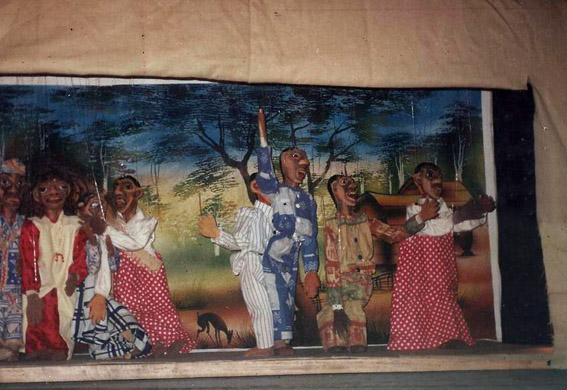
Puppets existed a long time before European settlers took the current territory of Congo (ex Zaire). They were used in ceremonies like birth, circumcision, marriage, ecc., but until the independence nobody considered these performances as arts, so they were suppressed and replaced by traditional western theatre (Molière, ecc.), seen as a major form of art at the colonial times. But in D. R. of the Congo, as in many other countries, puppets acts were not always linked to a specific ritual —and in some events like the Festival Culturel de Gungu (started in 2000), in the province of Bandundu, organizers try to emphasize the value of the performance by itself.
Around 1980, the French Cultural Center in Kinshasa —currently Insitut Français Halle de la Gombe— started organizing some workshops in collaboration with the INA and the puppeteers Genevieve Vedrenne, Gisèle and Raymond Poirson (France), Peter Klassen and Bernard Kleybolt (Germany) and Danaye Kanlanfei (Togo). These workshops led to the foundation of the company Théâtre de Marionnettes du Zaire, who played with foam puppets. Mavese Mbizi, Malvine Bike, Kapita Tshingombe and Tshamala Mufubela attended those workshops and they are the pioneers of modern puppets in D. R. of the Congo.
Note:
The content of this article has been elaborated from conversations with Patience Fayulu, individual member of UNIMA Africa, the materials he presented at the ManiganSes Festival in Saguenay and a few quotes from the ‘Encyclopédie Mondiale des Arts de la Marionnette’, edited by UNIMA International (2009), made by Fayulu himself.

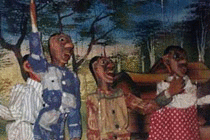
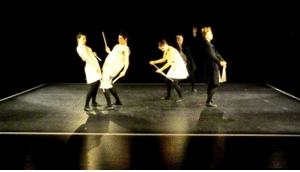
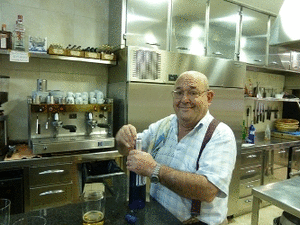

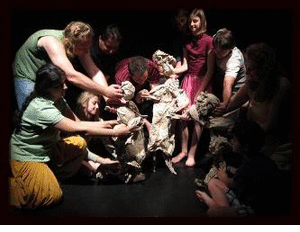


















Une fois de plus merci pour la publication. Je suis tres content du travail car tu as fait un bon boulot. Nous devons soutenir ce genre des projet a Kinshasa car ces enfants sont l’avenir de demain.